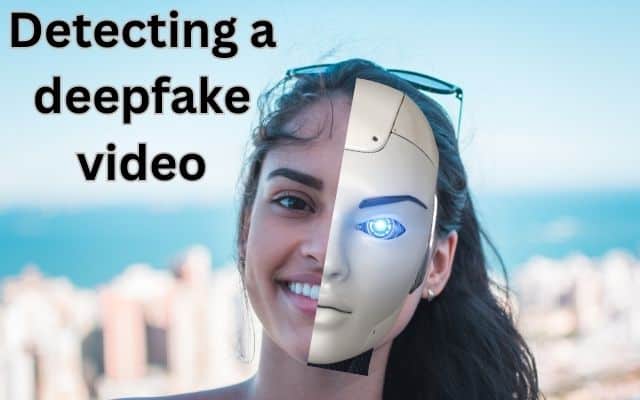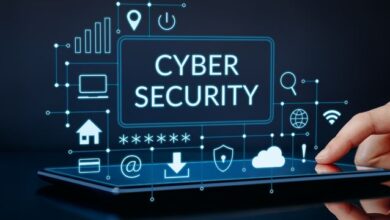Detecting a deepfake video: How can you tell

Detecting a deepfake video: How can you tell: Look for unnatural eye movements, inconsistent facial expressions, and signs of image manipulation. Deepfake technology has become a significant concern due to its ability to create convincing but false video content. These manipulated videos are often utilized to spread misinformation and can have serious implications, including influencing public opinion and elections. As a result, it is crucial to understand how deepfakes work and how to identify them. Here are the characteristics of deepfakes and provide 15 telltale signs to help you spot them. By being aware of these indicators, you can protect yourself from falling victim to this evolving technology.
What is a Deepfake?
“Deepfake” means deep learning with something that is fake. Deepfakes employ artificial intelligence (AI) techniques, leveraging doctored images and sounds created using machine-learning algorithms. This technology manipulates media to make it seem like people are saying or doing things they never said or did. It first gained notoriety in 2017 when a Reddit user called “deepfakes” shared manipulated pornographic videos created by face-swapping celebrities’ faces onto others’ bodies using Google’s open-source deep-learning technology.
How do Deepfakes Work?
To identify deepfakes: it is helpful to understand their underlying mechanisms. One common method involves the use of Generative Adversarial Networks (GANs), which employ algorithms to train themselves to recognize patterns. This training enables GANs to produce fake images that closely resemble real characteristics.
Another technique involves the use of AI algorithms known as encoders in face-swapping and face-replacement technology. These algorithms compare thousands of face shots of two individuals to identify similarities. A second AI algorithm called a decoder then retrieves and swaps these face images, allowing someone’s real face to be superimposed onto another person’s body.
The Purpose of Deepfakes
Deepfakes are created with the intention of deceiving viewers into believing false content. They are commonly employed to spread misinformation, engage in phishing scams, perpetrate hoaxes, manipulate elections, create celebrity pornography, and conduct identity theft or financial fraud. In some cases, individuals may be targeted with blackmail threats, where a fake but damaging video is threatened to be released unless certain demands are met.
Spotting Deepfake Videos: 15 Telltale Characteristics
Detecting deepfake videos can be challenging, but there are several key characteristics that can help you identify them. While advanced AI technology may be required for precise detection, here are 15 things to look for when determining if a video is real or fake:
- Unnatural eye movement, such as a lack of blinking or eye movements that do not follow the person they’re talking to.
- Unnatural facial expressions or facial morphing occurs when one image is stitched over another.
- Awkward facial-feature positionings: a misalignment between the face and nose.
- Lack of appropriate emotion displayed on the face in relation to what is being said.
- Awkward-looking body or posture, with unnatural body shape or inconsistent head and body positioning.
- Unnatural body movement, including distorted or jerky movements that appear disjointed.
- Unnatural colorings, such as abnormal skin tone, discoloration, strange lighting, or misplaced shadows.
- Hair that doesn’t look real, as individual characteristics like frizz or flyaways may not be accurately generated.
- Teeth that don’t look real, with the absence of outlines for individual teeth potentially indicating manipulation.
- Blurring or misalignment at the edges of images, particularly where the face and neck meet the body.
- Inconsistent noise or audio, including poor lip-syncing, robotic-sounding voices, or strange word pronunciation.
- Unnatural images when slowed down, reveal bad lip-syncing or other discrepancies.
- Hashtag discrepancies, where changes in cryptographic algorithm-inserted hashtags indicate manipulation.
- Digital fingerprints, utilize blockchain technology to create unalterable records that prove a video’s authenticity.
- Reverse image searches, comparing an image or video with similar content online to determine if it has been altered.
Technological Solutions for Detecting a deepfake video
Several organizations and researchers are actively working on developing tools and techniques to detect deepfakes. Some notable initiatives include:
- Social media platforms like Twitter and Facebook banning the use of malicious deepfakes.
- Google’s efforts to create text-to-speech conversion tools for speaker verification.
- Adobe’s system allows content creators to attach a signature specifying the details of their creation, and their ongoing development of facial image manipulation detection tools.
- University researchers use machine learning and soft biometrics to detect deepfakes with high accuracy.
- The Deepfake Detection Challenge (DFDC) is an organization sharing a dataset of 124,000 videos to foster innovation and collaboration in deepfake detection.
- Deeptrace is a startup developing automated deepfake detection tools for background scans of audiovisual media.
- The U.S. Defense Advanced Research Projects Agency (DARPA) funding research through the MediFor program to automate deepfake screening using media forensics.
The Battle Between Deepfakes and Detection
The development of deepfake detection algorithms leads to countermeasures by the creators of deepfakes. This ongoing cycle highlights the need for vigilance and awareness among users. By understanding the characteristics of deepfakes and being cautious about online content, you can reduce the risk of being deceived. Additionally, advancements in detection technology and the collaborative efforts of organizations and researchers contribute to ongoing progress in combating deepfake threats.
FAQ
Q: What is a deepfake?
A: A deepfake is a form of manipulated media created using artificial intelligence (AI) techniques. It involves altering or replacing elements in a video or audio clip to make it appear as though someone is saying or doing something they didn’t actually say or do.
How can you tell if a video is a deepfake?
Look for unnatural eye movements, inconsistent facial expressions, and signs of image manipulation, among other characteristics. It is also helpful to stay informed about emerging detection technologies and strategies.
Q: How are deepfakes used?
A: Deepfakes can be used for various purposes, including spreading misinformation, creating fake celebrity pornography, conducting phishing scams, manipulating elections, and engaging in identity theft or financial fraud.
Q: Can deepfake videos be detected?
A: Detecting deepfake videos can be challenging, but there are certain characteristics that can be indicators, such as unnatural eye movements, facial expressions, and body movements. Researchers and organizations are developing AI-based tools and detection techniques to identify deepfakes more effectively.
Q: What can I do to spot a deepfake video?
A: There are several strategies to help identify deepfake videos, such as looking for inconsistencies in facial features, unnatural body movements, abnormal coloring, or audio sync issues. Additionally, staying updated on emerging detection technologies and being cautious when consuming and sharing online content can help mitigate the risks of falling for deepfakes.
Q: Are there efforts to combat deepfakes?
A: Yes, various organizations, including social media platforms like Twitter and Facebook, are implementing policies to prohibit malicious deepfakes. Researchers are actively working on developing advanced detection technologies, and initiatives like the Deepfake Detection Challenge (DFDC) encourage collaboration and innovation in deepfake detection.
Q: How can I protect myself from deepfake videos?
A: It’s important to approach online content with skepticism, verify information from multiple reliable sources, and be cautious when sharing or forwarding videos that may be suspicious. Staying informed about the characteristics of deepfakes and being aware of the latest detection techniques can also help in protecting yourself from falling victim to deepfake videos.
- How to Design a Pinterest Pin in Canva
- How to Fix “Video Cannot be Played” on Google Drive
- What’s up with YouTube TV video quality?
- 15 Most Successful Video Games
Conclusion
Deepfake videos pose a significant challenge in the era of misinformation and online manipulation. By familiarizing yourself with the telltale signs of deepfakes and staying informed about the latest detection technologies, you can protect yourself from falling victim to this evolving technology. Remember to approach online content with skepticism, exercise caution when sharing sensitive information, and stay up to date with the efforts being made to combat deepfakes.




